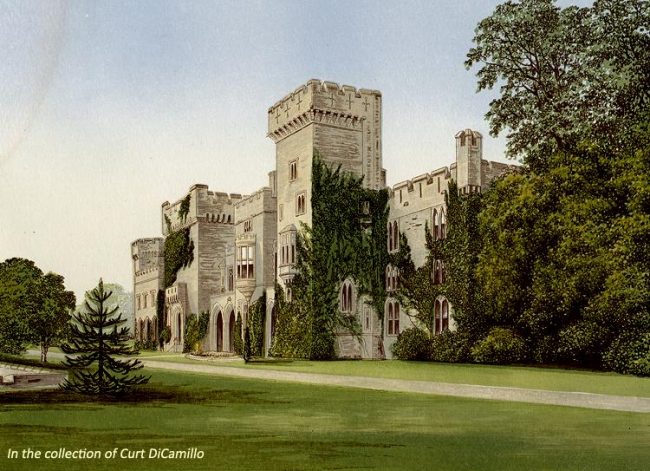
The house from "Morris's County Seats," circa 1875.
Earlier Houses: There was an earlier house on, or near, the site of the current house.
Built / Designed For: Richard Payne Knight
House & Family History: Downton Castle was one of the first examples of an asymmetrical house built in the Picturesque Style. Richard Payne Knight, a garden designer, an antiquarian, and an artistic theorist, designed the house for himself and filled it with striking rooms: the high Pantheon-style dining room in the center of the house; the drawing room, with its genuine antique porphyry columns; and the follies in the park. Knight famously dismissed the Elgin Marbles as second-rate when the debate was raging about their acquisition by the nation; however, he was very prescient in 1791 when he suggested that the Apollo Belvedere, the Farnese Hercules, and the Belvedere Torso were Roman copies from the 2nd century AD, rather than Greek originals (Payne was correct). During the Victorian era the round entrance tower, the chapel, the Gothic Ballroom, and the Gothic-Tudor staircase were added. During World War II Lancing College in West Sussex was evacuated to Downton Castle; one of the school's students, Tom Sharpe, later used Downton Gorge and the castle as the inspiration for Handyman Hall in his 1975 novel, "Blott on the Landscape" (turned into a BBC TV series in 1985 and filmed at nearby Stanage Hall). Sharpe's fellow student, children's writer Malcolm Saville, used Downton Castle as a basis for Bringewood Manor in his 1958 novel "The Secret of the Gorge." Bryanston Limited purchased Downton Castle in 1979; the house is today a private residence.
Collections: Sir William Hamilton's collection of antique bronzes was sold to Richard Payne Knight in the late 18th century. Knight's collection of 111 engraved gems (intaglios and cameos) was bequeathed by him to the British Museum in 1824. Knight also had an important collection of pictures, including works by van Dyck, Salvator Rosa, Turner, Ruysdael, and Rembrandt, including Rembrandt's "Flight into Egypt" and "The Cradle." Rembrandt's "St. Bartholomew" was sold in 1962 for $532,000 to J. Paul Getty of Sutton Place, Surrey; then in 1971 it was donated to the J. Paul Getty Museum in California. Some contents, including Gerard Dou's "Old Woman Drinking Soup," were sold at Christie's on May 4, 1979 to a foreign party for £110,000. Claude Gelée's "View of La Crescenza" was purchased by the Metropolitan Museum of Art in 1978. Sir Anthony van Dyck's "A Rearing Stallion" was sold by the Kincaid-Lennox descendants on July 8, 2008 at Christie's London for £3,065,250. A 1794 portrait of Richard Payne Knight by Sir Thomas Lawrence is today in the collection of The Whitworth Art Gallery, University of Manchester. The painting was commissioned for the Library at Downton and accepted in 1970 by HM Treasury in lieu of death duties from the Estate of Major Kincaid-Lennox of Downton Castle.
Comments: Peter Reid called Downton Castle a "building of national importance."
Garden & Outbuildings: Knight put up a number of follies: a castle, the Roman Baths, bridges, and a cave with windows cut out of rock. Repton wrote "When I compare the picturesque scenery of Downton Vale with the meager efforts of art which are attributed to the school of Brown, I cannot wonder at the enthusiastic abhorrence which the author of ‘The Landscape' expresses for modern gardening." The Downton Estate stood at 14,000 acres in the 1970s; by 1986 the estate was down to 1,827 acres, a further part of which was sold that year. Downton Gorge is leased to English Nature as a National Nature Reserve.
Architect: Thomas Farnolls Pritchard
Designed: May have assisted Knight in design and building of HouseArchitect: John Nash
Designed: May have designed all or part of HouseJohn Preston (J.P.) Neale, published under the title of Views of the Seats of Noblemen and Gentlemen in England, Wales, Scotland, and Ireland, among other titles: 2.S. Vol. III, 1826.
Country Life: XLII, 36, 1917.
Title: Enlightenment: Discovering the World in the Eighteenth Century
Author: Sloan, Kim; Burnett, Andrew (Editors)
Year Published: 2003
Reference: pg. 135
Publisher: Washington, DC: Smithsonian Books
ISBN: 158834164X
Book Type: Hardback
Title: Art Treasures of England: The Regional Collections
Author: Waterfield, Giles; et al.
Year Published: 1998
Reference: pg. 88
Publisher: London: Royal Academy of Arts
ISBN: 0900946598
Book Type: Softback
Title: Desire & Excess: The Nineteenth-Century Culture of Art
Author: Siegel, Jonah
Year Published: 2000
Reference: pg. 58
Publisher: Princeton: Princeton University Press
ISBN: 0691049149
Book Type: Softback
Title: Vases and Volcanoes: Sir William Hamilton and His Collection
Author: Jenkins, Ian; Sloan, Kim
Year Published: 1996
Reference: pg. 101
Publisher: London: British Museum Press
ISBN: 0714117668
Book Type: Softback
Title: Burke's & Savills Guide to Country Houses, Volume II: Herefordshire, Shropshire, Warwickshire, Worcestershire
Author: Reid, Peter
Year Published: 1980
Reference: pgs. 20-21
Publisher: London: Burke's Peerage
ISBN: 0850110319
Book Type: Hardback
Title: Disintegration of a Heritage: Country Houses and their Collections, 1979-1992, The
Author: Sayer, Michael
Year Published: 1993
Publisher: Norfolk: Michael Russell (Publishing)
ISBN: 0859551970
Book Type: Hardback
House Listed: Grade I
Park Listed: Grade II*
Past Seat / Home of: SEATED AT EARLIER HOUSE: Hopton family, 16th century. Richard Knight, until 1749. SEATED AT CURRENT HOUSE: Richard Payne Knight, 1778-1824; Charlotte Knight, 1824-43; Andrew Rouse-Boughton-Knight, 19th century. Major William Mandeville Peareth Kincaid-Lennox, 20th century.
Current Ownership Type: Individual / Family Trust
Primary Current Ownership Use: Private Home
House Open to Public: No
Historic Houses Member: No